David Suzuki's Blog, page 61
July 29, 2015
The joy of converting brown to green
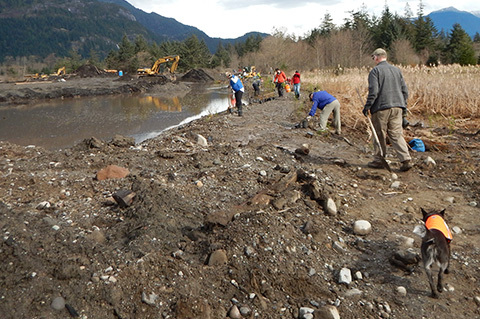
By Anuradha Rao, Marine Planning Specialist
I remember the first time I helped clean up a brown site devoid of nature. A month later, the new growth was overwhelming, as if all the plants were saying, "Thank you." This sparked my interest in ecological restoration.
Ecological restoration -- and brownfield restoration in particular -- is a big topic in Squamish, B.C. Brownfield restoration involves converting a site that has been so degraded it can't return to the ecosystem it once was without intervention. The Squamish River Watershed Society's current brownfield restoration project aims to restore a decommissioned log-sorting site to estuary and wetland habitat. Earlier work restored another brownfield, bringing migratory birds back to the Squamish estuary.
The project -- which includes six partners, five funders, a dozen team members and 100 volunteers -- expands on the earlier estuary restoration. The restoration will bring back sedge marsh, which is found in seasonally flooded areas, by lowering the land gradient. The soil removed will fill the former wetland nearby and an old access road will be decommissioned. Tidal channels will be built to reconnect land and sea. An access trail for the community will balance public use and habitat recovery.
Bringing nature back so close to the centre of town connects people to the wealth of nature in their own backyards and brings communities together. "The most exciting part is seeing the community's reaction as the area is being transformed," says SRWS executive director Edith Tobe, remembering volunteer planting days in March. "The people coming out were so excited. One lady -- a mother with her children -- got stuck in the mud and just couldn't stop laughing. She hasn't had that much fun for as long as she can remember."
This estuary is within the Squamish River Important Bird Area. The project will bring back fish and wildlife, including salmonids and migratory birds that use the estuary and the larger Howe Sound region. The society is also measuring the area's role in carbon sequestration, and may boost it by transplanting eelgrass in adjacent coastal waters. Estuaries and wetlands are increasingly important as we contend with the impacts of climate change. The David Suzuki Foundation's study of Howe Sound found that estuaries and wetlands provide up to $174,712 in ecosystem benefits per hectare each year. They supply water, sequester and store carbon, cycle nutrients, provide habitat, regulate storms and process waste. These ecosystems also provide valuable services such as recreation, tourism, science and education.
Interested in getting involved? Contact the SRWS by email or at 604-898-9171 for information on planting parties this fall.
Join us and speak up for Howe Sound »
Hey! Want more DSF? Join David Suzuki on Facebook

July 28, 2015
Don't bee fooled: neonics are still toxic to honeybees
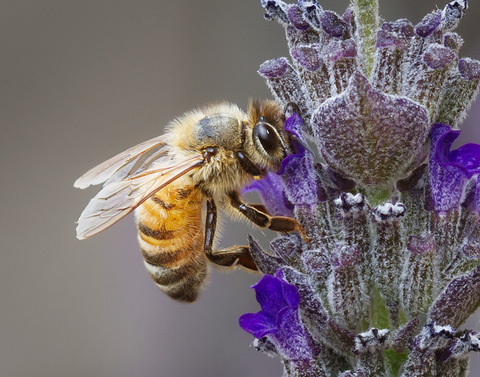
(Credit: Sandy & Chuck Harris via Flickr)
Did you hear that the honeybee crisis is over? This bold and surprising pronouncement appeared in Margaret Wente's July 22 Globe and Mail column, "Good news: There is no honeybee crisis". Wente cites the latest survey statistics from the Canadian Association of Professional Apiculturists, which indicate fewer losses of Canadian honeybee colonies this past winter than the previous one. It is good news -- although overwintering losses in Ontario were still double the level beekeepers suggest is sustainable.
Wente stretches the limits of this good news with the claim that fewer honeybee losses last winter mean we no longer need to be concerned about the harmful effects of neonicotinoid pesticides on planetary ecosystems. She wrongly states, "most research shows little to no impact." An independent analysis of more than 1,200 scientific studies on neonics concluded that they threaten numerous species, including honeybees, bumblebees, birds, worms and butterflies. Exposure to low, non-lethal levels of neonics can cause long-term harm to honeybees, affecting feeding behaviour and reproduction and making bees more vulnerable to disease. For Wente to dismiss evidence that neonicotinoid pesticides harm ecosystems is like denying that smoking causes cancer because your grandfather smoked a pack a day and lived to be 98.
Wente also overstates the value of neonics to crop production. Italy banned neonic seed treatments on corn in 2008, and production didn't suffer. In Canada, these chemicals continue to be used extensively -- virtually all corn planted in Ontario and 60 per cent of soybeans are treated with neonics -- yet a leaked federal government analysis estimates neonic seed treatments contribute just 0.4 per cent of the total value of soy production in Canada and 3.6 per cent in the case of corn.
Honeybee health is affected by several, interrelated factors. Ending routine overuse of neonicotinoid pesticides that are toxic to bees, as Ontario's new regulations will do, will help diminish one known threat. That's good news for all of us who are concerned with the plight of pollinators. Let's remember that healthy pollinators play an essential role in food production!
Will there be an end to the honeybee crisis? One thing Wente got right in her column is that there's keen public interest in the plight of pollinators. We need to keep this issue buzzing. We can each do our part by planting bee and butterfly-friendly plants and calling on all levels of government to work toward a phase-out of neonics. Together we can bring bees back from the brink.
Hey! Want more DSF? Join David Suzuki on Facebook

How to help bumblebees
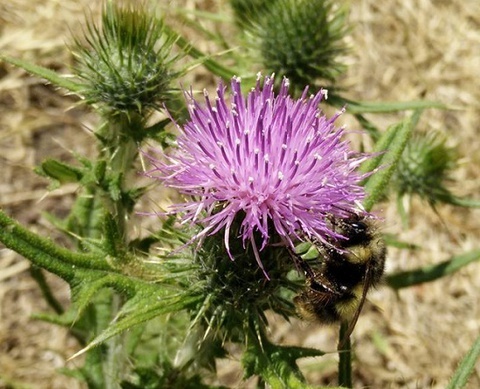
Learn how to make a bumblebee nest! (Credit: Lindsay Coulter)
Did you know that there are about 250 species of bumblebees and they all need our help? To identify one, just look at the colour of its tail -- and a few other details!
There are three kinds of bumblebees, those that nest:
Underground
At ground level
Above ground
In addition to pollinating wild plants and food plants like tomatoes and blueberries, bumblebees that nest in the ground benefit your garden by:
Improving soil quality
Increasing water movement around plant roots
Mixing up soil nutrients
How to make bumblebees welcome
Most common species prefer dry, dark places. Your yard is probably home to a few types of bumblebee nests -- some can contain up to 400 bees!
Underground nest opportunities include abandoned mouse holes, under garden sheds and in compost heaps.
Ground-dwelling bumblebees will also nest in a compost pile -- some love the heat.
Above-ground bumblebees will take over any bird house you didn't clean out! They also make nests in thick grass and in tree cavities.
How to make a bumblebee nest
This DIY bumblebee house comes from a beekeeper friend: Grab a plastic plant pot. Fill it about two-thirds full of dryer lint (nesting material). Tip it upside down and place it at ground level, in a shady area. Place an old plate on top and a rock -- that weigh enough to hold the plastic pot in place while leaving the pot's holes open for ventilation.
Find more detailed bumblebee house "how to" instructions, complete with images, from the Bumblebee Conservation Trust (PDF), Garden World and the Renewable at Home blog.
Be a good neighbour to bumblebees and don't disturb them. They have work to do!
Sincerely, Lindsay Coulter
A fellow Queen of Green
Hey! Want more DSF? Join David Suzuki on Facebook

July 23, 2015
Premiers' energy strategy doesn't go far enough

(Credit: Kris Krug via Flickr)
On July 15, a state-of-the-art new pipeline near Fort McMurray, Alberta, ruptured, spilling five million litres of bitumen, sand and waste water over 16,000 square metres -- one of the largest pipeline oil spills in Canadian history. Two days later, a train carrying crude oil from North Dakota derailed in Montana, spilling 160,000 litres and forcing evacuation of nearby homes.
At the same time, while forest fires raged across large swathes of Western Canada -- thanks to hotter, dryer conditions and longer fire seasons driven in part by climate change -- Canadian premiers met in St. John's, Newfoundland, to release their national energy strategy.
The premiers' Canadian Energy Strategy focuses on energy conservation and efficiency, clean energy and reducing greenhouse gas emissions to combat climate change. But details are vague and there's no sense of urgency. We need a response like the U.S. reaction to Pearl Harbor or the Soviet Sputnik launch!
The premiers seemingly want it both ways. Despite its call to "Build on the ongoing efforts of individuals, businesses, governments and others to improve energy efficiency, lower the carbon footprint, and improve understanding of energy in Canada," the strategy promotes fossil fuel business as usual, including expanded pipeline, oil sands and liquefied natural gas development, including more fracking.
The premiers' plan is a non-binding framework, described as a "flexible, living document that will further enable provinces and territories to move forward and collaborate on common energy-related interests according to their unique strengths, challenges and priorities." It doesn't include specifics on how to revamp our energy production and distribution systems, but buys time until the next elections roll around.
Although the language about climate change and clean energy is important, the strategy remains stuck in the fossil fuel era. As Climate Action Network Canada executive director Louise Comeau said in a news release, "Governments discriminate against smoking and toxics in food and consumer products. What's needed now is discriminatory policy against fossil fuels if we are going to drastically reduce the carbon pollution putting our health and well-being at risk."
Fossil fuel development has spurred economic development, created jobs and provided many other benefits, but the risks now outweigh those benefits. The costs in dollars and lives of pollution, habitat and wildlife degradation, pipeline and railcar spills, and climate change -- all getting worse as populations grow, energy needs increase and fossil fuel reserves become increasingly scarce and difficult to exploit -- have become unsustainable.
Even job creation is no longer a reason to continue our mad rush to expand development and export of oil sands bitumen, fracked gas and coal. Many fossil fuel reserves are now seen as stranded assets that will continue to decline in value as the world shifts to clean energy and the scramble to exploit resources gluts the market. The Climate Action Network points out that Clean Energy Canada's 2015 report on renewable energy trends showed that "global investors moved USD$295 billion in 2014 into renewable energy-generation projects -- an increase of 17 percent over 2013."
Yet, many of our leaders are still pinning their hopes on rapid oil sands expansion, massive increases in fracking for liquefied natural gas and new and expanded pipelines across the country -- with benefits flowing more to industry than citizens.
It's refreshing to see provincial premiers at least recognizing the threat of climate change and the need to address it through conservation, efficiency and clean technology, but we need a far greater shift to keep the problems we've created from getting worse. There are many benefits to doing so, including more and better jobs, a stronger economy, healthier citizens and reduced health-care costs, and greater preservation of our rich natural heritage.
The recent spate of pipeline and railcar oil spills, along with disasters like the 2010 Deepwater Horizon explosion in the Gulf of Mexico, are the result of rapid expansion of fossil fuel development, as industry and governments race to get the dirty products to market before demand dries up.
Canada's premiers should take these issues seriously and commit to a faster shift from fossil fuels as they continue to develop their energy strategy. They must also stress the importance of having similar, stronger action from the federal government -- and so should we all.
Hey! Want more DSF? Join David Suzuki on Facebook

July 22, 2015
Answering nature's call: 30x30 results 2015
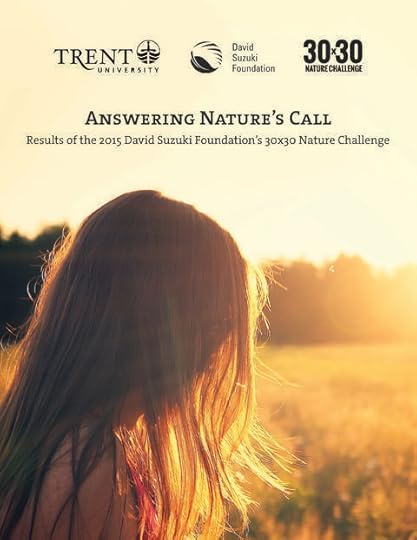
This report summarizes survey data from the 2015 30×30 Nature Challenge participants.
Hey! Want more DSF? Join David Suzuki on Facebook

July 21, 2015
How to get your yard off grass

Bumblebees, native bees and butterflies love lavender. And it's deer resistant!
Lawn history is rooted in wealth and status.
In 17th century England, only rich landowners had lawns (a monoculture of short, manicured grass). Work once done by sheep increasingly shifted to human labour, especially closer to the house. Before lawnmowers, only a few could afford to hire people to scythe and weed their grass.
Lawn's purpose? Purely decorative.
Given today's reality...
Water shortages
The health benefits of digging in dirt
Our passion for clean, local food
A desire to waste less
How busy we say we are
No need to show how much money you make
...I think society is ready to question, even ditch, the lawn habit.
What to do instead of seeding, mowing and aerating your lawn?
Plant a pollinator garden
If you don't plant for pollinators, who will? Anyone can provide essential habitat for bees, butterflies, moths, beetles, hummingbirds and other pollinators.
Join our #GotMilkweed campaign to help bring monarch butterflies back from the brink!
Design a rain garden
A rain garden helps minimize the problem of storm water runoff -- hundreds of litres of rainwater streaming off hard surfaces like roofs, roads and driveways. For example, shallow beds 15- to 30-centimetres (six- to 12-inches) deep filled with native plants will filter up to 90 per cent of pollutants. Rain gardens also allow water to drain deep enough into the soil to help recharge groundwater supplies. Find more tips to design your very own rain garden.
Plant a tree
A team of researchers (including the David Suzuki Foundation's own Faisal Moola) found that 10 more trees on a city block has self-reported health benefits comparable to a $10,000 salary raise (so you can feel richer without showing off your lawn), moving to a neighbourhood with a $10,000 higher median income or being seven years younger.
The study, conducted in Toronto, also found that people who live on a tree-lined block are less likely to report high blood pressure, obesity, heart disease or diabetes.
Xeriscape
It's a fancy word for water-wise gardening. Use up to 50 per cent less water by xeriscaping or landscaping with native plants better adapted to your area. Our yards can become a lot more like the nature once was.
A variety of front yard landscaping options await you! How have you transformed your yard?
Sincerely, Lindsay Coulter
A fellow Queen of Green
Hey! Want more DSF? Join David Suzuki on Facebook

July 17, 2015
David Suzuki Foundation statement on Alberta oil spill
As provincial premiers prepare to release an agreement on a Canadian energy strategy, the recent Fort McMurray oil leak -- one of the biggest in Canadian history -- raises troubling questions.
This leak, involving five million litres of bitumen, sand and wastewater, should remind premiers of the risks involved with expanding fossil fuel production and increasing pipeline infrastructure. This bitumen spill happened near a populated, well-resourced city. If proposed pipelines are built, more bitumen will travel through remote and under-resourced areas, where cleanup possibilities will be limited. The vegetation that makes up muskeg, where the Fort McMurray spill happened, will be virtually impossible to adequately clean up.
Canada's premiers should see this as yet another opportunity to show leadership in transitioning from an outdated fossil fuel economy to a burgeoning clean-technology and renewable-energy future. In the lead-up to the UN climate summit in Paris in December, promoting pipeline and oilsands expansion now will ensure that we miss the opportunity to do our part in keeping temperature increases below dangerous levels.
Pipeline spills like this are a reminder that you can't have climate leadership and fossil fuel expansion at the same time.
Media contact:
Ian Hanington
778-871-1782
Jay Ritchlin
604-961-6840
Hey! Want more DSF? Join David Suzuki on Facebook

July 16, 2015
Is the climate crisis creating a global consciousness shift?

(Credit: Nattu via Flickr)
When an assassin killed Archduke Franz Ferdinand of Austria in 1914, no one called it the start of the First World War. That happened years later, after the implications, consequences and scale of the response could be assessed. It's often the way. That's why historians are important; they put events in context.
Similarly, I doubt anyone knew how our world would change after Steve Jobs and Steve Wozniak built their first computer in Jobs' parents' garage in 1975.
In 1988, when climate scientist James Hansen testified in Washington that human-caused global warming was kicking in, people might have been excused for failing to grasp the significance of his early warning. But there's no excuse for humanity's subsequent dismissal and denial of the reality of his statements and the deliberate, aggressive opposition to any action to reduce the threat.
For years, environmentalists have called for an urgent response to runaway climate change. Evidence has poured in from around the world to corroborate Hansen's conclusions, from melting glaciers, sea level rise and ocean acidification to increasing extreme weather events and changes in animal and plant behaviour and ranges.
Despite the evidence, few governments have taken the necessary steps to reduce greenhouse gas emissions. Instead of listening to scientists and citizens, many leaders have chosen to heed the fossil fuel industry's massive PR machine and right-wing ideologues who see the call for global action as a socialist threat to capitalism.
There has been progress, at national and subnational levels, and among forward-thinking corporations and organizations. Some, like the commitment by countries including Denmark and Germany to reduce dependence on fossil fuels after the 1973 Arab oil embargo, were in response to markets rather than the climate crisis, but it positioned them well as evidence for climate change mounted.
More recently, people on the frontlines of climate change such as Pacific Islanders and Inuit have warned of the changes they're experiencing. The insurance industry and a number of corporations have called for action, with some, like Tesla, designing solutions. But many in the media and government continue to downplay the problem.
I've been astounded by the lack of response over the years, but I'll go out on a limb and suggest a shift is now taking place. Although we may not recognize its significance without the benefit of hindsight, we appear to be in the early stages of something huge.
Even some news outlets are shifting. The U.K.'s Guardian decided earlier this year to increase its coverage of climate change, going so far as to encourage divestment from the fossil fuel industry. The New York Times decided to use the more accurate term "denier" rather than "skeptic" to refer to those who reject the overwhelming evidence for human-caused climate change.
People power is another sign of the growing shift: 400,000 at the largest climate march in history in New York in September, with 2,646 simultaneous marches in 162 countries; an unprecedented gathering of 25,000 in Quebec City in advance of a premiers' climate change summit in April; and more than 10,000 in Toronto (including me) on July 5 for the March for Jobs, Justice and the Climate in advance of the Climate Summit of the Americas.
When Pope Francis reached beyond the world's 1.2 billion Catholics to call for action on climate change, his message was endorsed by other religious leaders and organizations, including the Dalai Lama, the Islamic Society of North America, an influential group of Jewish rabbis and the Church of England.
Beyond visible evidence of the increasing willingness to meet the challenge of global warming, one of the biggest signs of a shift has been the almost unnoticed but spectacular increase in renewable energy investment in countries like the U.S., Brazil and China.
It's easy for governments and industry to prioritize corporate profits and short-term gain over the best interests of complacent citizens. But when enough people demand action, take to the streets, write to business, political and religious leaders and talk to friends and family, change starts happening. We never know how big it will be until it's occurred -- but this time, it looks like it could be monumental! Let's hope so.
Hey! Want more DSF? Join David Suzuki on Facebook

July 15, 2015
Salmon: The latest casualties of climate change
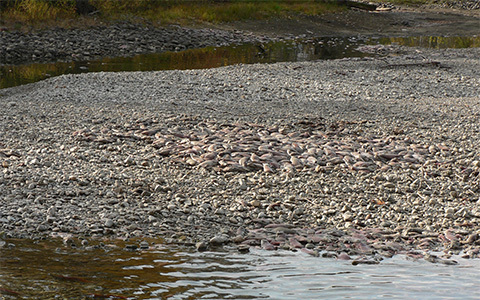
(Photo credit: Jeffery Young)
Guest blog by Mark Angelo, a river conservationist, writer, teacher and paddler who founded B.C. Rivers Day and World Rivers Day
The long stretch of hot, dry weather in B.C. this summer is great for outdoor recreation. It's not so good, however, for local streams and the wildlife they support. I've spent lots of time in creeks close to my home in Burnaby in Metro Vancouver lately and I've never seen water levels so low this early in the summer. We're already seeing conditions in many creeks that you would normally expect to see in late August.
In addition to low stream flows, we're seeing disturbing increases in water temperatures. We started experiencing record highs in coastal water temperatures in fall 2014 and they've continued this year. The optimal water temperature range for both trout and salmon is 13 to 18 C, with temperatures above 20 creating stress for the fish. Our Burnaby creek temperatures are now between 21 and 22 C. The neighbouring Fraser River has been recording temperatures close to 20.
Weather-related and climate-change-exacerbated events this year on both the South Coast and Vancouver Island have created a "perfect storm" for our waterways. We had a near-record low snowpack, followed by a warmer than usual May and June. What little snow there was disappeared quickly, followed by prolonged warm and dry conditions. In addition to the impacts on fish, this has also resulted in ideal conditions for the many forest fires raging around the province.
Fewer young fish are predicted to survive these conditions. We could also see less robust spawning rates for returning salmon, more fish dying before they spawn and a greater susceptibility of fish to parasites, disease and predators if these conditions persist. This could result in millions of premature salmon deaths across the province, with the Fraser River and east Vancouver Island perhaps most affected.
As stream flows continue to drop, fish will have less available habitat. I've already seen in several streams fish clustering in the few remaining deep water holes. In addition, we may be entering a new El Niño phase, which could result in even lower salmon returns in many places.
I'm concerned that extreme climate-impacted weather events such as we've been experiencing in B.C. will become more common. South Coast streams, which have traditionally been fed by both rain and snowmelt, could become largely rain-fed over time. That would mean higher flows in the fall, winter and spring, and much lower flows and higher water temperatures in the summer.
Fisheries and Oceans Canada is closing some fisheries to protect vulnerable salmon. It's still too early to know how effective this will be. The fact that the DFO is still keeping some coastal recreational chinook fisheries open is something that should be re-examined.
Sockeye salmon, pushed by climate constraints, are already at the southern extent of their range. Fraser River sockeye are under threat, with a recent study predicting up to 21 per cent less catch by 2050 due to climate change alone. Add in factors such as pollution and habitat destruction and the situation could be even more dire. All of this highlights the need for an even more precautionary approach to the fishery.
As a long-time river advocate, I know all too well that our rivers already face threats ranging from pollution and urbanization to excessive water extraction for resource development and dam building. In the end, climate change may pose the biggest threat of all -- and what we're experiencing this summer may well be a harbinger of things to come.
Hey! Want more DSF? Join David Suzuki on Facebook

Premiers going in one direction on climate action, the world in another
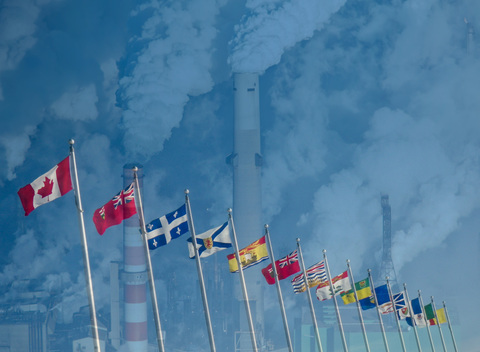
If Canada's premiers sign an agreement this week to speed up oil sands pipelines they will be out of step with much of the world, which is now recognizing the need for unprecedented action on climate through a phase-out of fossil fuels. They will be giving a green light to the expansion of dirty, expensive bitumen projects and squandering a moment, perhaps unique, of extraordinary hope and possibility.
While the World Bank, G7, and International Energy Agency have expressed concern about climate, the last few weeks have seen the emergence of developments that are more impressive still.
In May, Pope Francis issued his Encyclical on Care for Our Common Home, a document remarkable for the depth of its analysis and the radical vision of its solutions. It urges a breathtaking revision of our relationship with nature, one that sees us not as masters but as partners and stewards. Central to the Pope's message is a call for the phased replacement, "without delay", of fossil fuels. While the premiers seem poised to increase the use of this form of energy, the church leader urges rejection of it.
On July 8, Quebec Premier Philippe Couillard signed the Under 2 MOU which commits signatories -- including Ontario, California and 16 other jurisdictions -- to limit the global temperature increase to below 2 C. In practical terms this means reducing GHG emissions by up to 95 per cent below 1990 levels by 2050. While the federal government has agreed to decarbonize in 85 years, Ontario and Quebec are planning a near decarbonization in just 35. As part of California's commitment, the state expects to reduce its use of petroleum in cars and trucks by as much as 50 per cent by 2030 -- just 15 years from now! These pledges from subnational governments -- which, unlike the World Bank, for example, can be voted out of office if their policies prove unpopular -- are dizzying in their speed, boldness and courage.
But it's not just religious leaders and progressive politicians who are calling for previously unthinkable policies. It is also world scientists.
On July 10, the UNESCO-organized scientific conference Our Common Future under Climate Change issued a statement suggesting the world needs GHG emission cuts of 40 to 70 per cent below current levels within 35 years. The statement argues that "any upper limit on warming requires carbon dioxide emissions to fall eventually to zero" and urges a phase-out of fossil fuel subsidies. How different this is from the Canadian Energy Strategy expected to be inked this week by the premiers' Council of the Federation.
One can only speculate why the premiers as a whole are embracing pipeline expansion. Surely they know that 85 per cent of Canada's oil must remain in the ground if we're to keep temperature rise below the crucial 2 C threshold. Whatever their motive for oil-sands growth, they are very much at odds with the thrust of world opinion -- popular, religious and scientific -- at this exhilarating moment in history.
Hey! Want more DSF? Join David Suzuki on Facebook

David Suzuki's Blog
- David Suzuki's profile
- 247 followers



